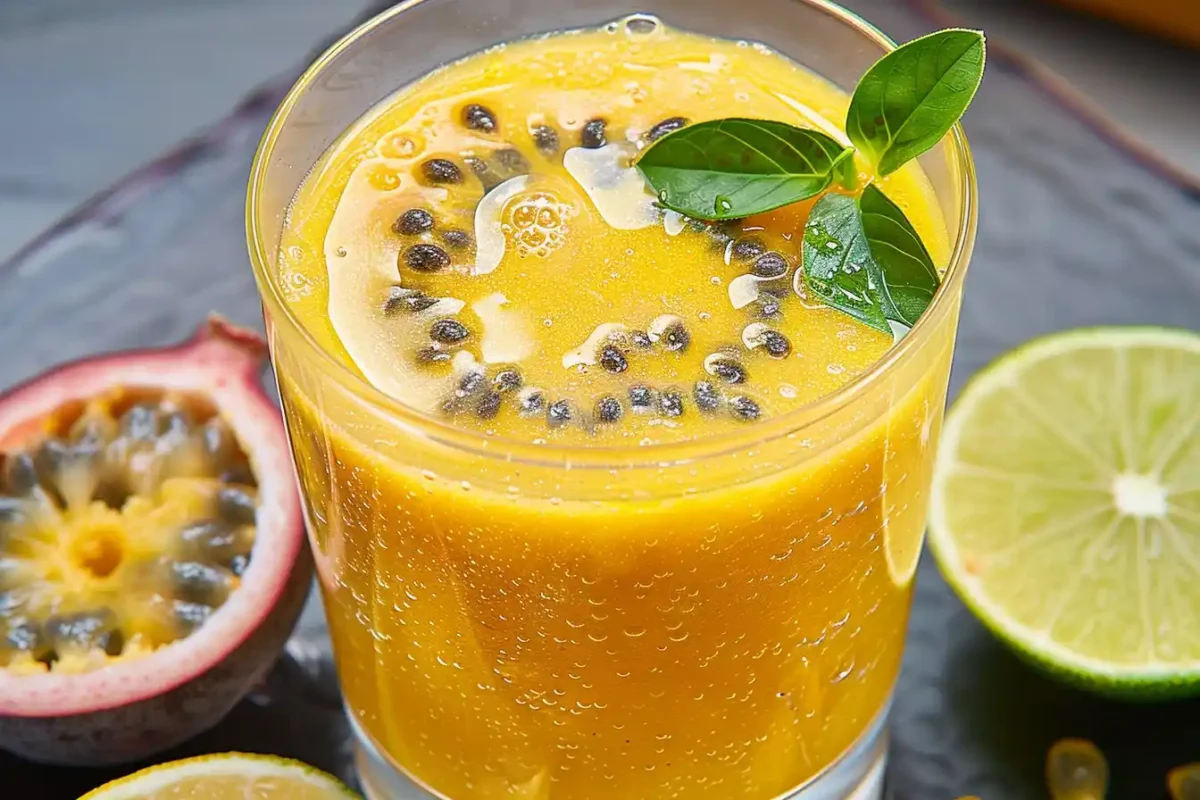This article explores everything about the maracuya, from its unique flavor to its uses. Discover the wonders of this tropical fruit.
What is Maracuya? A Detailed Look
The maracuya, also known as passion fruit, is a tropical fruit. It is known for its unique taste and aroma. It grows on a vine. The fruit is round or oval in shape. Its skin can be yellow or purple. Inside, it has juicy pulp and many seeds. It is very popular in many parts of the world. It is especially common in South America. Its distinct flavor makes it a favorite ingredient.
The Origin and Growth of Maracuya
Plants thrive in warm climates. They require plenty of sunshine and water. These plants are vines, and they climb easily. The flowers are very beautiful. They are usually white or purple. After the flower, the fruit begins to form. The fruit takes a few months to ripen. The skin will change color when it is ready. Furthermore, the fruit will feel heavier.
The Flavor Profile
The taste is quite unique. It is both sweet and tart. It has a tangy taste. Additionally, some describe it as slightly acidic. The aroma is very fragrant and fruity. The balance of sweet and sour makes it very versatile. It can be used in many recipes. This flavor profile makes it great for drinks, desserts, and more. The flavor is very intense.
How to Select a Ripe Maracuya
Choosing the best is important. Ripe fruits should feel heavy. The skin should be slightly wrinkled. Also, a ripe fruit will have a deep color. Avoid fruits that are too hard or green. These are not ready to eat. Always look for fruits that give slightly to pressure. This indicates that the fruit is ripe and ready.
Nutritional Benefits
The is not only tasty but also full of good things. It has many vitamins and nutrients. For instance, it has vitamin C and vitamin A. Moreover, it is a good source of fiber. It has important minerals too. Therefore, adding it to your diet is very healthy. Furthermore, it offers many health benefits.
The Impact on Health
Maracuya is beneficial for your health. The fiber it contains helps with digestion. Furthermore, it supports regular bowel movements. The antioxidants help protect your body. They fight harmful free radicals. It also promotes good heart health. Finally, it helps boost your immune system. Thus, it is a great choice for a healthy lifestyle.
How to Use Maracuya in Recipes
It is a versatile fruit in cooking. It can add a special touch to many dishes. It is especially great in desserts and drinks. In addition, you can use it in sauces and dressings. Moreover, the juice is perfect for cocktails. The possibilities are endless. It is, therefore, an excellent addition to your kitchen.
Maracuya Juice and Drinks
One popular way to enjoy it is as a juice. It is very refreshing. You can blend the pulp with water. Add some sweetener if needed. Furthermore, you can mix it with other fruit juices. Juice is also great in cocktails. It gives a tangy twist. Indeed, it is perfect for summer days. Additionally, it’s popular in smoothies.
Maracuya in Desserts
It adds a tropical flavor to desserts. You can make mousse. It is light and delicious. Also, it is great in cheesecakes and ice cream. Pudding is another delightful treat. Additionally, sauce can be served with cakes. It is therefore, a perfect way to enhance any dessert.
Maracuya in Savory Dishes
Besides desserts, it can be used in savory dishes. The pulp can be added to salad dressings. It creates a bright, tangy flavor. Furthermore, it is great in marinades for meats. Sauce is also good with seafood. Additionally, it can be a unique addition to chutneys. Therefore, this fruit is very flexible in cooking.
Where to Find this tropical fruit
It can be found in many grocery stores. Look in the produce section. Sometimes it might be in the exotic fruit area. You can also find it at farmer’s markets. In some regions, they grow locally. Therefore, consider searching there. Furthermore, always make sure the fruit is ripe before buying it.
Buying and Storing of this tropical fruit
When buying, check for good quality. The skin should be smooth and heavy. Avoid fruits with soft spots. To store, keep it at room temperature. It will ripen faster. Once ripe, store it in the fridge. It should last for a few days. Thus, you can enjoy it longer.
Different Cultures
Maracuya is popular in many cultures. In South America, it is a staple fruit. It is used in many dishes and drinks. Additionally, different regions have unique ways of using it. The is therefore, deeply woven into many cultures. It plays a role in local cuisine.
In Colombian Culture
In Colombia, maracuya is very popular. It is often used in juices and desserts. Lollipops are also common. It is indeed, a part of everyday life there. The people there appreciate its unique flavor. Therefore, it holds a special place in their culture. Furthermore, it is an important ingredient in Colombian cuisine.
Maracuya Seeds: To Eat or Not To Eat?
The seeds are edible. Some people eat them. They are crunchy and add texture. However, some people prefer to remove them. It is a personal preference. The seeds are generally safe to consume. Nevertheless, if you are unsure, you can remove them. Seeds don’t impact the flavor much.
The Best Ways to Use Maracuya Seeds
If you choose to eat the seeds, you can enjoy them. They are great in smoothies for added crunch. They can also be used in baked goods. In addition, seed oil is available. It has many nutrients. Therefore, seeds can be part of a healthy diet. They also make a nice addition to your dishes.
Versatility
The is, as has been demonstrated, a very versatile fruit. You can use it in so many ways. Its unique flavor goes well with many ingredients. This flexibility makes it a perfect choice for cooking. Whether you are making something sweet or savory, it can make it better.
The Endless Possibilities
You can experiment with in the kitchen. Try it in new and different recipes. You might discover your favorite way to use it. This versatile fruit has so much to offer. Therefore, start adding it to your diet today. You will certainly enjoy it in many ways. It is both healthy and delicious.
A Summary
In conclusion, the is a very special fruit. It is packed with flavor. It also has many health benefits. The is easy to use in recipes. It can be used in drinks, desserts, and savory dishes. It is truly a versatile fruit. Therefore, if you haven’t tried it, you should do so soon. You will definitely enjoy its unique qualities.
Embracing the Tropical Goodness of Maracuya
It is easy to see why is so loved. Its flavor is distinctive. It is also very good for you. The is a wonderful addition to any diet. It can make any meal a bit more special. Embrace the tropical goodness of this amazing fruit. You will find endless ways to enjoy it.
Frequently Asked Questions About Maracuya
Are maracuya and passion fruit the same?
Yes, maracuya and passion fruit are the same. The name varies depending on the region. Both terms refer to the same fruit. They share the same flavor and look. Therefore, whether you call it or passion fruit, it’s the same tropical delight. They are both known for their tangy, sweet taste.
Is it safe to eat maracuya seeds?
Yes, it is safe to eat maracuya seeds. They are edible and often consumed with the pulp. They have a crunchy texture. Seeds also contain good nutrients. However, some people prefer not to eat them due to texture. Therefore, it is mostly a matter of preference. But there are no health concerns related to eating them.
What does maracuya taste like?
has a sweet and tart flavor. It has a very tangy taste with a slightly acidic undertone. Its taste is very refreshing and fruity. It is a unique balance of sweet and sour. This makes it a perfect ingredient in many recipes. Its flavor is often described as very intense and distinctive.
What is maracuya in Colombia?
In Colombia, is a very popular fruit. It is used in many juices, desserts, and treats. It is part of the daily diet of many Colombians. It is considered a local staple. It has a special place in their culinary traditions. You can find it in many Colombian dishes and drinks. The is a favorite there.
END OF ARTICLE

